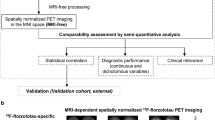Abstract
Purpose
Florbetaben is a β-amyloid-targeted PET tracer with significant potential for augmenting the toolbox in the clinical diagnosis of Alzheimer’s disease (AD). In dementia imaging, shortening of scan duration may simplify future clinical use. The aim of this retrospective study was to investigate the effect of scan duration on diagnostic accuracy.
Methods
PET scans obtained from 25 AD patients and 25 healthy volunteers (HVs) were analysed. In each subject, scans of three different durations (5, 10 and 20 min; all starting 90 min after injection) were obtained, randomized, and visually assessed by three experts blinded to the subject’s identity and group affiliation. Presence/absence of β-amyloid and diagnostic confidence (0–100 %) were scored, and 10 % of the scans were re-read. Further, randomly selected datasets of ten AD patients and ten HVs were quantified using an established VOI-based approach and using a voxel-based approach.
Results
The sensitivity and specificity of the blinded read were 80 % and 96 %, respectively, for all scan durations. Diagnostic confidence was high (97 ± 6 %, 97 ± 6 % and 95 ± 8 % for the 20-min, 10-min and 5-min scans, respectively; n.s.), as was interreader agreement (kappa20 min = 0.94, kappa10 min = 0.94, kappa5 min = 0.89; n.s.). Intrareader agreement was highest for the 20-min scan (kappa = 1.00) and lower for the 10-min scan (kappa = 0.71) and 5-min scan (kappa = 0.80; p = 0.002 and 0.003 vs. the 20-min scan). For all scan durations, composite SUVRs (Cohen’s d effect size 4.5, 3.9 and 4.8 for the 5-min, 10-min and 20-min scans; p < 0.0001 each) and individual brain volumes affected by β-amyloid (Cohen’s d effect size 1.6, 1.8 and 2.0 for the 5-min, 10-min and 20-min scans; p < 0.005 each) were significantly higher in AD patients than in HVs.
Conclusion
Reduction in scan duration did not relevantly affect the accuracy of florbetaben PET scans in discriminating between AD patients and HVs. Thus, a reduction in scan duration seems conceivable for the future clinical use of florbetaben.




Similar content being viewed by others
References
Karran E, Mercken M, De Strooper B. The amyloid cascade hypothesis for Alzheimer’s disease: an appraisal for the development of therapeutics. Arch Neurol. 2011;68:398–403.
Selkoe DJ. The molecular pathology of Alzheimer’s disease. Neuron. 1991;6(4):487–98.
Barthel H, Gertz HJ, Dresel S, Peters O, Bartenstein P, Buerger K, et al. Cerebral amyloid-β PET with florbetaben (18F) in patients with Alzheimer’s disease and Healthy controls: a multicentre phase 2 diagnostic study. Lancet Neurol. 2011;10:424–35.
Herholz K, Ebmeier K. Clinical amyloid imaging in Alzheimer’s disease. Lancet Neurol. 2011;10:667–70.
Lister-James J, Pontecorvo MJ, Clark C, Joshi AD, Mintun MA, Zhang W, et al. Florbetapir F-18: a histopathologically validated beta-amyloid positron emission tomography imaging agent. Semin Nucl Med. 2011;41:300–4.
Vallabhajosula S. Positron emission tomography radiopharmaceuticals for imaging brain beta-amyloid. Semin Nucl Med. 2011;41:283–99.
Barthel H, Luthardt J, Becker G, Patt M, Hammerstein E, Hartwig K, et al. Individualized quantification of brain β-amyloid burden: results of a proof of mechanism phase 0 florbetaben PET trial in patients with Alzheimer’s disease and healthy controls. Eur J Nucl Med Mol Imaging. 2011;38:1702–14.
Tzourio-Mazoyer N, Landeau B, Papathanassiou D, Crivello F, Etard O, Delcroix N, et al. Automated anatomical labeling of activations in SPM using a macroscopic anatomical parcellation of the MNI MRI single-subject brain. Neuroimage. 2002;15(1):273–89.
Drzezga A. Amyloid-plaque imaging in early and differential diagnosis of dementia. Ann Nucl Med. 2010;24:55–66.
Suotunen T, Hirvonen J, Immonen-Räihä P, Aalto S, Lisinen I, Arponen E, et al. Visual assessment of [(11)C]PIB PET in patients with cognitive impairment. Eur J Nucl Med Mol Imaging. 2010;37:1141–7.
Clark CM, Schneider JA, Bedell BJ, Beach TG, Bilker WB, Mintun MA, et al. Use of florbetapir-PET for imaging beta-amyloid pathology. JAMA. 2011;305:275–83.
Wolk DA, Grachev ID, Buckley C, Kazi H, Grady MS, Trojanowski JQ, et al. Association between in vivo fluorine 18-labeled flutemetamol amyloid positron emission tomography imaging and in vivo cerebral cortical histopathology. Arch Neurol. 2011;68:1398–403.
Kukull WA, Larson EB, Reifler BV, Lampe TH, Yerby MS, Hughes JP. The validity of 3 clinical diagnostic criteria for Alzheimer’s disease. Neurology. 1990;40:1364–69.
Jellinger K, Danielczyk W, Fischer P, Gabriel E. Clinicopathological analysis of dementia disorders in the elderly. J Neurol Sci. 1990;95:239–58.
Cselényi Z, Jönhagen ME, Forsberg A, Halldin C, Julin P, Schou M, et al. Clinical validation of 18F-AZD4694, an amyloid-β-specific PET radioligand. J Nucl Med. 2012;53:415–24.
Acknowledgments
We thank all AD patients and the HVs who took part in this trial, and their caregivers. Further, the excellent support of the cyclotron, radiochemistry, and PET teams of the University of Leipzig, Department of Nuclear Medicine, is gratefully acknowledged. We thank in particular Vinzenz Waberzeck and Anita Seese for their support in preparing the PET data analysis.
Conflicts of interest
S.T., H.B. and O.S. received consulting fees, speaker honoraria, and travel or accommodation expenses from Bayer Pharma AG. C.R. is an employee of Bayer Pharma AG. D.B., S.H., M.P. and H.J.G. declare no conflicts of interest.
Author information
Authors and Affiliations
Corresponding author
Additional information
Funding
Bayer Pharma AG
Solveig Tiepolt and Henryk Barthel contributed equally to this work.
Rights and permissions
About this article
Cite this article
Tiepolt, S., Barthel, H., Butzke, D. et al. Influence of scan duration on the accuracy of β-amyloid PET with florbetaben in patients with Alzheimer’s disease and healthy volunteers. Eur J Nucl Med Mol Imaging 40, 238–244 (2013). https://doi.org/10.1007/s00259-012-2268-8
Received:
Accepted:
Published:
Issue Date:
DOI: https://doi.org/10.1007/s00259-012-2268-8




